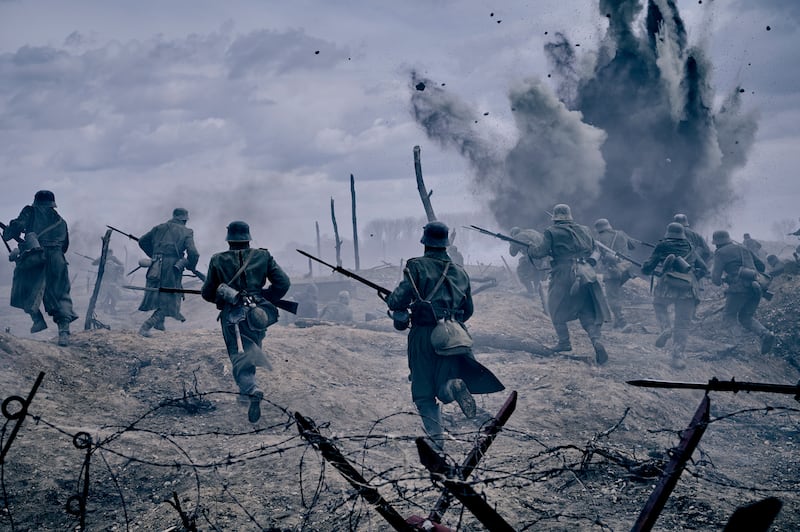Seeing the familiar title on the screen, one could be forgiven for thinking, “not that again”. Erich Maria Remarque’s indestructible All Quiet on the Western Front, a key text of the first World War, has, however, attracted the interest of surprisingly few adaptors since its publication in 1928. Lewis Milestone’s still-chilling 1930 version became the third film to win the Oscar for best picture. A 1979 TV movie with Richard “John-Boy Walton” Thomas received polite notices. Edward Berger’s new bone-rattling film is, in fact, the first feature adaptation to open commercially in cinemas for close to a century (this Netflix production does that before moving rapidly to streaming).
Berger and his team prove up to the task. There is a certain flattening of the characters. Some of the ironic juxtapositions are a tad on-the-nose. But the combat sequences are as impressive as anything commercial cinema has delivered over the last decade — grubbier, nastier and noisier than those in Sam Mendes’s theatrically choreographed 1917. The first appearance of tanks suggests that, to harried German soldiers, the effect was similar to encountering invasion by a technologically superior alien species. Blaring electronic klaxons over the escalating mayhem, Volker Bertelmann’s score helps press home the dislocation from everyday human existence. Here is where the 20th century really began.
The writers have deviated significantly from the source novel — one late change is notably daring in an age where “faithfulness” is seen as a virtue in itself — but the basic framework of the story is still in place. Young Paul Bäumer (Felix Kammerer) lies about his age in order to join his friends at the front in 1917. That date is significant. The film argues that, even so late in the war, blind patriotism still motivated German youth. Within days, they have been cruelly, sometimes fatally, disabused of their idealism.
Whatever wiser prognosticators may have suspected, neither Remarque nor Milestone were working with certain knowledge of the Great War’s malign legacy. Inserting scenes of politicians and army officers negotiating the armistice, this first German-language feature adaptation leans into the notion that we are seeing merely the first act of a conflict that didn’t properly end until 1945. One particularly hot-headed general predicts that “Social Democrats” will bring about the “end of Germany”. This was pretty much Hitler’s argument. The politician Matthias Erzberger (Daniel Brühl, now playing the nabobs) warns Allied negotiators that, if their conditions are too harsh, the defeated nations may come to “hate the peace”. There is already a sense of betrayal even before the eleventh hour of the eleventh month has arrived.
Dancing with the Stars: ‘I’ve had the best time of my life. I feel super fit,’ chef Kevin Dundon says as he is voted off show
Oscars 2025 red carpet: Ariana Grande sets the standard while Timothée Chalamet stood out in ‘Kerrygold’ yellow
Róisín Ingle puts a Thermomix to the test: ‘I am a convert but there’s one enormous catch’
Life without children: ‘I’d want the investment my mother had, but I don’t have it in me. I don’t have the grá for it’

All this works effectively in the film’s middle distance. Less convincing are the unsubtle cuts from soldiers eating turnip bread in the slime to shots of generals scoffing game and swilling claret. The point is irrefutable, but the montage is that of the broadest propaganda.
The noise and tumult is so overpowering we scarcely get a chance to engage with Paul’s friends. Berger does, however, manage some engaging comedy as, now aware that every lull is an escape from hell, they career about the countryside in search of food and female companionship. Those scenes could fit comfortably into a story about any war from the Spartans up to the current conflict in eastern Europe.
For all that, this version most comes alive during the extended battle sequences. There remains a guilty paradox here. Nobody could mistake All Quiet on the Western Front for anything other than an anti-war film, but the deafening, careering action — shot in predictably desaturated tones by James Friend — still works to create an unhealthy surge in the viewer. That contradiction is best appreciated on the biggest screen with the loudest sound. This is one of the things that cinema does.














